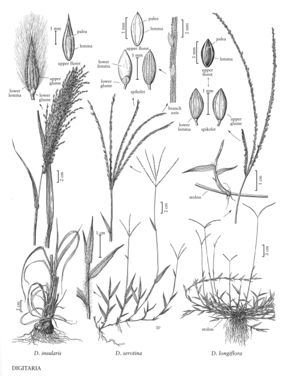Difference between revisions of "Digitaria insularis"
imported>Volume Importer |
imported>Volume Importer |
||
| Line 42: | Line 42: | ||
|publication year= | |publication year= | ||
|special status= | |special status= | ||
| − | |source xml=https:// | + | |source xml=https://bitbucket.org/aafc-mbb/fna-data-curation/src/2e0870ddd59836b60bcf96646a41e87ea5a5943a/coarse_grained_fna_xml/V25/V25_1067.xml |
|subfamily=Poaceae subfam. Panicoideae | |subfamily=Poaceae subfam. Panicoideae | ||
|tribe=Poaceae tribe Paniceae | |tribe=Poaceae tribe Paniceae | ||
Revision as of 21:00, 5 November 2020
Plants perennial; cespitose, shortly rhizomatous, with knotty bases. Culms 80-130 cm, erect, with densely villous cataphylls, branching from the lower and middle nodes. Sheaths usually sparsely to densely papillose-hirsute, occasionally glabrous; ligules 4-6 mm, usually lacerate, not ciliate; blades 20-50 cm long, 10-17 mm wide, lax, smooth or scabridulous abaxially, scabridulous to scabrous adaxially. Panicles 20-35 cm long, 2-10 cm wide, with numerous spikelike primary branches; primary branches 10-15 cm, appressed to ascending at maturity, axes not wing-margined or with wings less than 1/2 as wide as the midribs; internodes 3-4.5(6) mm (midbranch), bearing spikelets in unequally pedicellate pairs; secondary branches rarely present; pedicels not adnate to the branches; shorter pedicels 0.7-2 mm; longer pedicels 2.5-5 mm; terminal pedicels 2-5 mm. Spikelets 5.5-8.2 mm (including pubescence), 4.2-5.9 mm (excluding pubescence), narrowly ovate, acuminate. Lower glumes 0.6-0.8 mm; upper glumes 3.5-4.5 mm, 3-5-veined, pubescent on the margins; lower lemmas 4.1-5.7 mm (exceeded 1.5-5 mm by pubescence), narrowly ovate, 7-veined, pubescent between most, sometimes all, of the veins and on the margins, veins usually obscured by a dense covering of golden-brown hairs, hairs 3-6 mm, spreading at maturity, intercostal regions on either side of the midvein glabrous or pubescent with shorter, fine, white hairs, sometimes intermixed with the golden-brown hairs; upper lemmas 3.2-4.5 mm, narrowly ovate, brown when immature, dark brown at maturity, acuminate; anthers 1-1.2 mm. 2n = 36.
Distribution
Puerto Rico, Tex., Virgin Islands, Ala., Pacific Islands (Hawaii), Ill., Miss., Ariz., Fla.
Discussion
Digitaria insularis grows in low, open ground of the southern United States, and extends to the West Indies, Mexico, and through Central America to Argentina.
Selected References
None.
